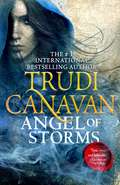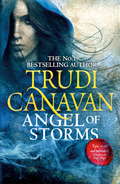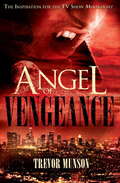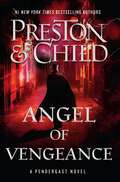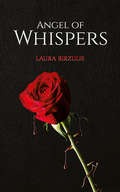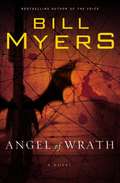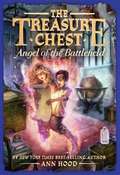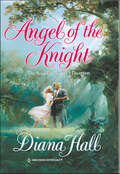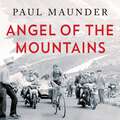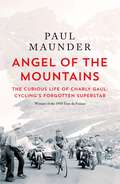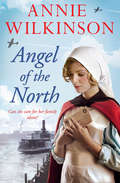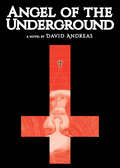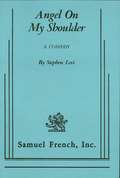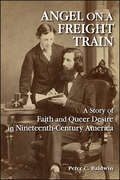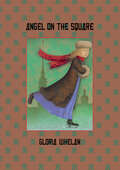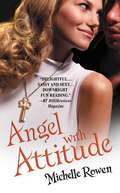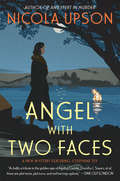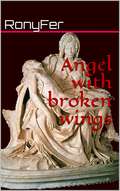- Table View
- List View
Angel of Smoky Hollow
by Barbara McmahonMusician Angelica Cannon arrived in Smoky Hollow, battered suitcase and precious violin in tow, to rediscover her passion for music- not to fall for the town's most eligible bachelor, Kirk Devon. Kirk's faded jeans and laid-back charm are a million miles away from the sharp-suited businessmen of New York. But his warm chocolate eyes most definitely put the harmony back into her soul! City girl Angelica has already fallen for Smoky Hollow's magic-now she's succumbing to Kirk's spell. . . ;.
Angel of Storms (Millennium's Rule #2)
by Trudi CanavanInternational No.1 bestselling author Trudi Canavan returns with the second novel in the Millennium's Rule series -- her most powerful and thrilling adventure yet. Tyen is teaching mechanical magic at a school respected throughout the worlds. News arrives that the formidable ruler of all worlds, long believed to be dead, is back and enforcing his old laws - including the one forbidding schools of magic. As teachers and students flee, Tyen is left with no home and no purpose...except the promise he made to Vella, the sorcerer imprisoned in a book. Tyen must decide what he is willing to do to free her. After five years among the tapestry weavers of Schpeta, Rielle's peaceful new life has been shattered by a local war. As defeat looms, the powerful Angel of Storms appears and invites Rielle to join the artisans of his celestial realm. But what will he require in return for this extraordinary offer? Escape to a new world. Discover the magic of Trudi Canavan.
Angel of Storms: The gripping fantasy adventure of danger and forbidden magic (Book 2 of Millennium's Rule) (Millennium's Rule #2)
by Trudi Canavan'ANOTHER PAGE-TURNER FROM ONE OF FANTASY'S BESTSELLING AUTHORS' IndependentFollowing Thief's Magic, international No. 1 bestselling author Trudi Canavan returns with the second novel in the Millennium's Rule series - her most powerful and thrilling adventure yet.A DARK DANGER LIES IN WAIT . . . Tyen trains students in the ways of magic, but his teaching may soon be outlawed. Rumour has it that the formidable ruler of all worlds, long believed to be dead, is back and is harshly enforcing his old laws - including the one forbidding schools of magic. As teachers and pupils flee, Tyen is left with no home and no purpose . . . except to fulfil the promise he made to Vella, the sorcerer imprisoned in a book. Tyen must decide what he is willing to do to free her.Elsewhere, Rielle's peaceful new life as a tapestry weaver has been shattered by a local war. As defeat looms, the powerful Angel of Storms appears and invites Rielle to join the artists of his heavenly realm. But what will he require in return for this extraordinary offer? A gripping fantasy adventure filled with danger, intrigue and forbidden magic. Perfect for fans of Robin Hobb, Brandon Sanderson, Patrick Rothfuss and Peter V. Brett.ESCAPE TO A NEW WORLD.DISCOVER THE MAGIC OF TRUDI CANAVAN.Praise for the Millennium's Rule series:'It's easy to see why Trudi Canavan's novels so often make the bestseller lists. Her easy, flowing style makes for effortless reading . . . Delightful worldbuilding . . . Vivid and enjoyable' SFX'A must for fans of Canavan's previous work and for fantasy fans in general' Press Association'Rielle's story entrances . . . leaving readers eager for the next two volumes' Publisher's Weekly'The world-building is tremendous. The magical system is sophisticated and fascinating' Striking Keys
Angel of Vengeance
by Trevor O. MunsonThe novel that inspired the TV series Moonlight puts a twist on the classic Dracula vampire tale and blends it with Chandler hardboiled P.I. detective fiction.LA-based P.I. and vampire Mick Angel has been hired by a beautiful red-headed burlesque dancer to find her missing sister. But the apparently simple case of a teenage runaway is soon complicated by drug dealers, persistent cops, murder, and Mick's own past. Mick must learn the hard way what every vampire should know - nothing stays buried for ever, especially not the past.
Angel of Vengeance (Agent Pendergast Series)
by Douglas Preston Lincoln ChildPreston & Child continue their #1 bestselling series featuring FBI Special Agent Pendergast and Constance Greene, as they take a final stand against New York&’s deadliest serial killer: Pendergast&’s own ancestor…and Constance&’s greatest enemy. A desperate bargain is broken… Constance Greene confronts Manhattan&’s most dangerous serial killer, Enoch Leng, bartering for her sister's life – but she is betrayed and turned away empty-handed, incandescent with rage. A clever trap is set… Unknown to Leng, Pendergast&’s brother, Diogenes, appears unexpectedly, offering to help—for mysterious reasons of his own. Disguised as a cleric, Diogenes establishes himself in New York's notorious Five Points slum, manipulating events like a chess master, watching Leng&’s every move…and awaiting his own chance to strike. A vengeful angel will not be deterred… Meanwhile, as Pendergast focuses on saving the unstable Constance in her fanatical quest for vengeance, she strikes out on her own: to rescue her beloved siblings from a tragic fate and take savage retribution on Leng. But Leng is one step ahead and has a surprise for them all…
Angel of Vengeance: The Girl Who Shot the Governor of St. Petersburg and Sparked the Age of Assassination
by Ana SiljakIn the Russian winter of 1878 a shy, aristocratic young woman named Vera Zasulich walked into the office of the governor of St. Petersburg, pulled a revolver from underneath her shawl, and shot General Fedor Trepov point blank. "Revenge!," she cried, for the governor's brutal treatment of a political prisoner. Her trial for murder later that year became Russia's "trial of the century," closely followed by people all across Europe and America. On the day of the trial, huge crowds packed the courtroom. The cream of Russian society, attired in the finery of the day, arrived to witness the theatrical testimony and deliberations in the case of the young angel of vengeance. After the trial, Vera became a celebrated martyr for all social classes in Russia and became the public face of a burgeoning revolutionary fervor. Dostoyevsky (who attended the trial), Turgenev, Engels, and even Oscar Wilde all wrote about her extraordinary case. Her astonishing acquittal was celebrated across Europe, crowds filled the streets and the decision marked the changing face of Russia. After fleeing to Switzerland, Vera Zasulich became Russia's most famous "terroristka," inspiring a whole generation of Russian and European revolutionaries to embrace violence and martyrdom. Her influence led to a series of acts that collectively became part of "the age of assassinations." In the now-forgotten story of Russia's most notorious terrorist, Ana Siljak captures Vera's extraordinary life story--from privileged child of nobility to revolutionary conspirator, from assassin to martyr to socialist icon and saint-- while colorfully evoking the drama of one of the world's most closely watched trials and a Russia where political celebrities held sway.
Angel of Whispers
by Laura BirzulisFinding true love, mastering angelic genes, enjoying vampire life - pure bliss. Or so Jade thought until vampire high council member Lobelia Glasston upturns Jade and Shane's happy ending, sending it crashing down around them. Shane is forbidden by vampire law to love Jade. Lobelia knows Jade is different, a supernatural weapon; however, she is missing a few crucial details, like the fact that she is a vampire-angel hybrid. Will she break them down and condemn their love? Shane and Jade fight to keep her hybrid secret. Will it be enough? Keeping their romantic involvement under wraps is one thing, but attempting to expose a mass genocidal killer hell-bent on destroying the kingdom that Shane has built may prove too much. Will their love crumple under the oppressive eyes of the council? Will Shane fall prey to the emotionally manipulative Lobelia? Will they catch the masochist before one of their loved ones is caught in the crossfire? Or will it all end in blood?
Angel of Wrath (Voice of God #2)
by Bill MyersThirteen-year-old Jazmin, her ex-Special Ops uncle Charlie, and former FBI agent Lisa are reunited in the second of the Voice of God series to stop an assassin driven to murder members of a megachurch led by Lisa's brother. This assassin has drawn in a coven of teens toying with satanic practices to support his efforts. The naive youth engage in ceremonies that appear to usher in the death of each of his victims. When their rituals open a portal into the spiritual realm, a terrifying and mysterious entity crosses over to our world. The battle culminates with the capture of Lisa's father as the next target and a Black Mass requiring both their deaths as a sacrifice. The team will, once again, have to rely on all their wits, strength, and faith to survive in this action-packed, unearthly warfare.
Angel of the Battlefield
by Ann HoodWhile exploring The Treasure Chest, Felix and Maisie are transported to a Massachusetts farm in 1836. Disappointed that they have not landed in their beloved New York City, they wonder why they were brought to Massachusetts to meet a young girl named Clara Barton. Perhaps Clara has a message for the twins? Or maybe they have one for her? .
Angel of the Knight (Warrior's Deception)
by Diana Hall'Twas a Hellish MatchWhat else could Falke de Chretian call it when he was unwillingly betrothed to a woman of few attractions and many secrets? But the Lady Gwendolyn hid a golden self beneath a drab exterior, and is heart was soon divided 'twixt her and a nameless night angel#151;a woman both mysterious...and strangely familiar!Though dismissed as the homely "Lady Wren," Gwendolyn was the true guardian spirit of her rightful lands, ministering tot he sick and helping the needy. Yet her soul slumbered in silent loneliness, until awakened by the earthly charms of devilish Falke de Chretian.
Angel of the Lake
by Ana SeymourKari, a newly-immigrated Norwegian, meets Josh, a hardworking American when he saves her from drowning when their boat goes down... will Josh's tragedies keep them apart?
Angel of the Mountains: The Strange Tale of Charly Gaul, Winner of the 1958 Tour de France
by Paul Maunder'Maunder's book is more than just a biography of the rise and fall of a complicated man . . . It is also a critique of the damage that myth-making and the media can do to an athlete; a study of what happens to a demigod when thrown from Mount Olympus' The TimesCharly Gaul is a forgotten cycling legend. Once a household name across Europe, the diminutive Luxembourger won the 1958 Tour de France and the Giro d'Italia twice. A unique rider, Gaul was supremely gifted at climbing and resilient even in the foulest weather. His pedalling style was smooth and swift, and he could set an unmatchable metronome rhythm on a mountain climb. 'Mozart on two wheels,' was how one contemporary writer described him; another dubbed him 'The Angel of the Mountains'.At the end of his cycling career Gaul disappeared, becoming a hermit living in a forest in Luxembourg. What drove Charly Gaul into a recluse's life? In Angel of the Mountains, Paul Maunder seeks to uncover the truth about Gaul, his psychology and the circumstances of his withdrawal from society. In rediscovering Gaul's enigmatic life, we find not only an unlikely hero but also a larger truth about the nature of sporting success.
Angel of the Mountains: The Strange Tale of Charly Gaul, Winner of the 1958 Tour de France
by Paul Maunder'Maunder's book is more than just a biography of the rise and fall of a complicated man . . . It is also a critique of the damage that myth-making and the media can do to an athlete; a study of what happens to a demigod when thrown from Mount Olympus' The TimesCharly Gaul is a forgotten cycling legend. Once a household name across Europe, the diminutive Luxembourger won the 1958 Tour de France and the Giro d'Italia twice. A unique rider, Gaul was supremely gifted at climbing and resilient even in the foulest weather. His pedalling style was smooth and swift, and he could set an unmatchable metronome rhythm on a mountain climb. 'Mozart on two wheels,' was how one contemporary writer described him; another dubbed him 'The Angel of the Mountains'.At the end of his cycling career Gaul disappeared, becoming a hermit living in a forest in Luxembourg. What drove Charly Gaul into a recluse's life? In Angel of the Mountains, Paul Maunder seeks to uncover the truth about Gaul, his psychology and the circumstances of his withdrawal from society. In rediscovering Gaul's enigmatic life, we find not only an unlikely hero but also a larger truth about the nature of sporting success.
Angel of the Mountains: The Strange Tale of Charly Gaul, Winner of the 1958 Tour de France
by Paul Maunder'Maunder's book is more than just a biography of the rise and fall of a complicated man . . . It is also a critique of the damage that myth-making and the media can do to an athlete; a study of what happens to a demigod when thrown from Mount Olympus' The TimesCharly Gaul is a forgotten cycling legend. Once a household name across Europe, the diminutive Luxembourger won the 1958 Tour de France and the Giro d'Italia twice. A unique rider, Gaul was supremely gifted at climbing and resilient even in the foulest weather. His pedalling style was smooth and swift, and he could set an unmatchable metronome rhythm on a mountain climb. 'Mozart on two wheels,' was how one contemporary writer described him; another dubbed him 'The Angel of the Mountains'.At the end of his cycling career Gaul disappeared, becoming a hermit living in a forest in Luxembourg. What drove Charly Gaul into a recluse's life? In Angel of the Mountains, Paul Maunder seeks to uncover the truth about Gaul, his psychology and the circumstances of his withdrawal from society. In rediscovering Gaul's enigmatic life, we find not only an unlikely hero but also a larger truth about the nature of sporting success.
Angel of the North
by Annie WilkinsonWho can she turn to when life gets tough? April 1941, Hull. Nurse Marie Larsen has grown used to the challenges of keeping Hull Royal Infirmary running during the Germans' attacks on her city. Amidst the sudden power cuts, blown out windows and with wounded civilians pouring into the hospital at each new attack, she always thanks her lucky stars that the latest bomb didn't have her name on it. But when a fresh wave of bombings tears Hull apart, this time tragedy strikes close to home. With her mother now critically ill in hospital, and her father missing, Marie will have some tough decisions to make if she is to keep her younger brother and sister, Alfie and Pam, safe. Amidst the chaos and uncertainty, it is Marie's beau, Chas Elsworth, who alone is able to keep her spirits up via letters and phone calls from his post. So when evidence comes to light that Chas might not be the dependable rock that Marie has come to rely upon - where can Marie turn for support? A gripping tale of ordinary people facing extraordinary challenges, Angel of the North, is perfect for fans of Katie Flynn and Margaret Dickinson.
Angel of the Overpass (Ghost Roads #3)
by Seanan McGuireThe third book of the Ghost Roads series returns to the highways of America, where hitchhiking ghost Rose Marshall continues her battle with her killer—the immortal Bobby Cross.Lady of shadows, keeper of changes, plant the seeds of faith within me, that I might grow and flourish, that I might find my way through danger and uncertainty to the safety of your garden. Let my roots grow strong and my skin grow thick, that I might stand fast against all who would destroy me. Grant to me your favor, grant to me your grace, and when my time is done, grant to me the wisdom to lay my burdens down and rest beside you, one more flower in a sea of blooms, where nothing shall ever trouble me again.Rose Marshall died when she was sixteen years old and on her way to her high school prom. She hasn&’t been resting easy since then—Bobby Cross, the man who killed her, got away clean after running her off the road, and she&’s not the kind of girl who can let something like that slide. She&’s been looking for a way to stop him since before they put her body in the ground.But things have changed in the twilight world where the spirits of the restless dead continue their &“lives.&” The crossroads have been destroyed, and Bobby&’s protections are gone. For the first time, it might be possible for Rose to defeat him.Not alone, though. She&’ll need every friend she&’s managed to make and every favor she&’s managed to add to her account if she wants to stand a chance…and this may be her last chance to be avenged, since what is Bobby Cross without the crossroads?Everything Rose knows is about to change.
Angel of the Underground: A Novel
by David AndreasA teenage girl in foster care confronts spiritual doubt and soul-chilling terror in “a sinister and atmospheric story that will appeal to horror fans” (Booklist).When three children in a Catholic group home are brutally murdered, the survivors are hurried into separate foster homes across Long Island. Robin Hills, a fifteen-year-old who has spent the past several years under religious care, is thrust into a new, dysfunctional family with no spiritual beliefs. No longer protected by the religion and the nun she had come to love, Robin is completely alone and enveloped in fear.As the murders continue and Robin fears she may become the next victim, her faith increasingly falters. However, she finds solace in a budding friendship with Dennis, a boy her age living in her new foster home. Dennis’s kindness, his acceptance of Robin, and his bravery in the face of evil—born of his passion for horror movies—combine to reassure her that she’ll survive the killings. Armed with this new friendship and fueled by a rage she finally discovers within herself, Robin must find the courage and self-reliance to confront the darkest aspects of human depravity.“Andreas’s debut novella, Angel of the Underground, will remind many horror fans of Stephen King’s first published novel, Carrie . . . Andreas’s tight and tense horror tale is a spellbinding and clever debut. He also has more on his mind than merely a straightforward thriller. His smart, sympathetic and engaging teen heroine grapples with the Catholic faith that has sustained her for so many years but now seems to have abandoned her. Proving good things come in small packages (the novel is just 165 pages), Angel of the Underground is a tight and thoughtful thriller, and a stellar introduction to a fresh new voice.” —Shelf Awareness“The grit in Angel is laudable—as is Andreas’ determination to push our faces right up into some very uncomfortable domestic horrors.” —Rue Morgue Magazine
Angel on My Shoulder: A Comedy
by Stephen LeviA beautiful young book illustrator is having an affair with her dream man, a ruggedly attractive owner of a demolition company. When he announces his intention to leave his family, Donna gets looped and awakes in the arms of an angelic looking man with "Wings" printed on his sweat shirt. He seems to know everything about her, including her present predicament. Complications ensue when the lover shows up suitcase in hand to discover Donna is sharing her apartment with her "guardian angel." Laughs and surprises come fast and furious as the men vie for Donna's affections.
Angel on a Freight Train: A Story of Faith and Queer Desire in Nineteenth-Century America
by Peter C. BaldwinAngel on a Freight Train examines the experiences of Samuel Edward Warren (1831–1909), a teacher and college professor in Troy, New York, who struggled to reconcile his same-sex erotic desires with his commitment to a Christian life. Unlike twenty-first-century evangelicals who try to "pray the gay away," Warren discerned no fundamental conflict between his faith and his attraction to younger males. Growing up in the antebellum Northeast, in a culture that permitted and even celebrated emotional bonds between men, he strove to build emotionally intense relationships in many overlapping forms—friendship, pedagogy, evangelism, and romance—which allowed him to enjoy intimacy with little effort at concealment. However, as he passed into mature manhood and built a prestigious career, Warren began to feel that he should have grown out of romantic friendships, which he now feared had become emotionally and physically excessive.Based on Warren's deeply introspective and previously unexplored diaries, Angel on a Freight Train traces his youthful freedom and sensuality, his attempt to join with younger men in a spirit of loving mentorship, and, finally, the tortured introspection of a man whose age seemed to shut him out from an idyllic lost world. In the end, Warren came to believe rather sorrowfully in a radical division between his angelic, ideal self and what he called "the freight train of animal life below."
Angel on a Leash: Therapy Dogs and the Lives They Touch
by David FreiDavid Frei, the publicist of Westminster Kennel Club and the founder of Westminster's therapy dog charity, Angel on a Leash, along with his wife Cheri, a minister at Morgan Stanley Children's Hospital of New York-Presbyterian, retell heartwarming stories of therapy dogs who change the lives of needy children at hospitals and rehabilitation centers. angelonaleash.org
Angel on the Square (The Russian Saga #1)
by Gloria WhelanIn the fall of 1914, safe behind palace walls, Katya Ivanova sees St. Petersburg as a magical place. The daughter of a lady-in-waiting to the Empress, Katya spends all her time with the Grand Duchesses; the royal family feels like her own. But outside the palace, a terrible war is sweeping through Europe, and Russia is beginning to crumble under the weight of a growing revolution. Now, as Katya's once-certain future begins to dissolve, she must seek to understand what is happening to her beloved country and, for the first time in her life, take charge of her own destiny.
Angel with Attitude
by Michelle RowenValerie Grace isn't sure why she was thrown out of Heaven. One minute she was conducting her angelic duties up in Heaven and the next minute she was spitting out water in the killer whale tank at MarineLand in Niagara Falls! She gets a job as a maid at the Paradise Inn but is determined to get back to Heaven- even though it means denying the advances of her sexy assigned Temptor Demon, Nathaniel.
Angel with Two Faces
by Nicola UpsonExhausted and disillusioned with the world of theater in May 1935, Josephine Tey has traveled to Cornwall to spend the summer with her friends the Motleys at their run-down but beautiful country estate. Ready to begin work on her second mystery novel, Tey finds much to inspire her in the landscape and its legends. Meanwhile, the Motleys have become involved in an amateur production at the nearby Minack Theater.Detective Inspector Archie Penrose has returned to his roots in Cornwall to attend the funeral of a family friend, a young estate worker who died in a tragic riding accident. Penrose has a few questions about the circumstances surrounding the fatal occurrence. And when the Minack Theater proves to be the stage for a real-life tragedy, Penrose and Tey together must investigate an audacious murder and confront an evil suggesting that there are darker things than death.
Angel with Two Faces (Josephine Tey #2)
by Nicola UpsonExhausted and disillusioned with the world of theater in May 1935, Josephine Tey has traveled to Cornwall to spend the summer with her friends the Motleys at their run-down but beautiful country estate. Ready to begin work on her second mystery novel, Tey finds much to inspire her in the landscape and its legends. Meanwhile, the Motleys have become involved in an amateur production at the nearby Minack Theater. Detective Inspector Archie Penrose has returned to his roots in Cornwall to attend the funeral of a family friend, a young estate worker who died in a tragic riding accident. Penrose has a few questions about the circumstances surrounding the fatal occurrence. And when the Minack Theater proves to be the stage for a real-life tragedy, Penrose and Tey together must investigate an audacious murder and confront an evil suggesting that there are darker things than death.
Angel with broken wings
by Ronyfer Federico RenziStories of struggle and perseverance of one of the many political refugees who had to leave their Latin American country to try their luck in one of the countries called "first world". Juan Ramon emigrated from his native Guatemala to take refuge with his wife Flor de Maria, escaping from the institutionalized repression, to face the cold and xenophobic Canadian society.Then; he suffers, as so many thousands of displaced and dispossessed who have lost everything. Or almost everything; because it perseverance, courage, love of life and capacity for solidarity is.

